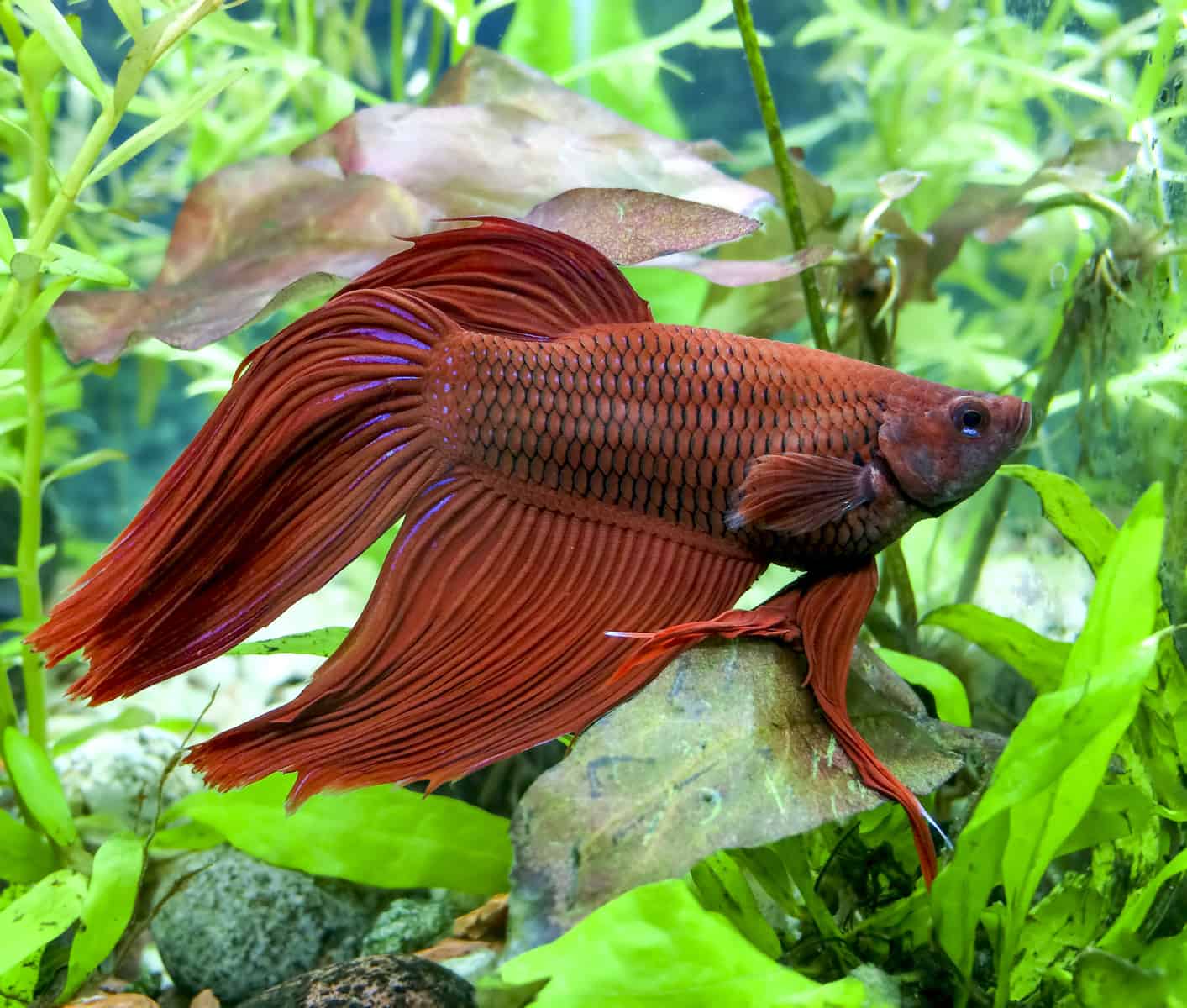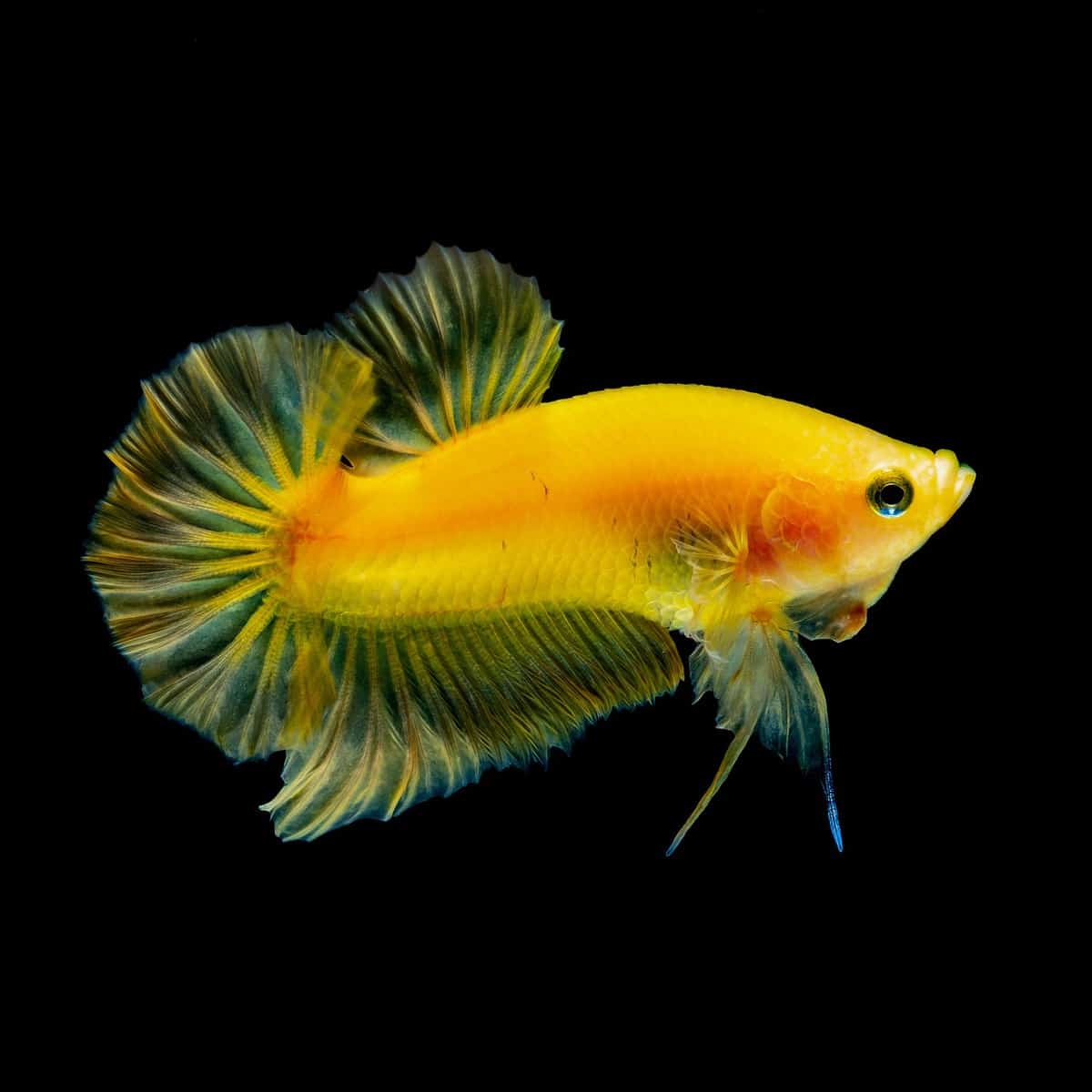Many betta owners use aquarium salt to treat their betta fish for common ailments and even to boost the betta’s overall health.
But the betta fish is a freshwater species that don’t live in salt water. So, how come you can use aquarium salt, and is it safe for your betta buddy?
In this article, we take a closer look at the potential uses of aquarium salt with bettas and how, when used properly, salt can be beneficial for your fish.
Can You Use Aquarium Salt For Bettas?
Unlike marine fish and invertebrate species, your betta is a freshwater fish that lives in water with no salt (sodium chloride) content. Bettas cannot live in saltwater environments, and salt water can actually kill betta fish if used improperly.
However, you may have read in some articles about fish health that aquarium salt can be used to tackle certain diseases. For example, to treat a betta with fin rot.
Some people even recommend using aquarium salt routinely to give your pet extra essential electrolytes that he needs for optimum health and well-being.
Aquarium salt is cheap, easily available wherever you are in the world, and never expires. That said, overdosing your tank with aquarium salt can be very dangerous and harmful to plants and your betta.
What Is Aquarium Salt?
Aquarium salt is essentially the same as regular table salt in its chemical makeup. Both these kinds of salts have the chemical formula, NaCI, representing chloride and sodium in the ratio of 1:1.
However, the primary and critical difference between regular salt and aquarium salt is that the latter contains no additives. Aquarium salt is simply derived from evaporated seawater.
Can You Safely Add Aquarium Salt to Your Betta Tank?
Provided that you don’t overdose the water, it is safe to use a small amount of salt in a betta tank to treat certain diseases.
However, we don’t recommend that you routinely add aquarium salt to your betta’s aquarium; he doesn’t need it for general health, and you may actually do more harm than good.
Also, there are some circumstances when it’s not a good idea to use salt in your fish tank, including the following:
Scaleless Species
If you have a community tank, that’s a great idea, as bettas do enjoy the company of peaceful companions. However, if your setup contains scaleless fish species, such as the Pictus catfish, you must not use aquarium salt in your tank.
That’s because salt dries out the slime coat on a scaleless fish species, essentially removing the fish’s natural protection from external infections and parasites and weakening its immune system.
Snails
Although most snail species can tolerate small doses of aquarium salt, if you use too much salt in the aquarium water will be sucked out of the snails’ bodies via osmosis.
That will eventually dehydrate the snails and kill them.
So, although moderate amounts of salt are fine, be wary of using too much salt in a tank containing snails.
Live Plants
If your tank contains live plants, you should be aware that many delicate species cannot tolerate salinity.
Hardier plant species such as Anubias, Java Moss, Anacharis, and Java Fern should be okay, provided that the salt level is not too high.
Bottom line: if you want to use aquarium salt to medicate your betta, it’s recommended that you do so by placing him in a quarantine tank rather than treating the entire setup with salt.
Beneficial Bacteria
Your aquarium needs beneficial bacteria to maintain healthy water quality and balance the nitrogen cycle. Those bacteria form colonies in the filter media inside your filter unit, on the substrate, viewing panes, and even on the decorations and plants in your tank.
Unfortunately, some fish medications and certain chemicals can kill or deplete the concentration of beneficial bacteria in the tank, potentially compromising the efficiency of your filtration system.
However, the species of bacteria you want to grow in your betta tank can withstand low concentrations of salinity without too much trouble.
That said, if the concentration of salt in the tank is too high, that can adversely affect the beneficial bacteria, damage the filtering mechanism, and lead to poor water quality.
What About Using Regular or Marine Salt?
So, can you use regular salt instead of aquarium salt?
No! You should never substitute regular table salt or Epsom salt for aquarium salt. Both those kinds of salt contain coloring, flavor enhancers, and other additives that could harm or even kill your betta buddy.
Using table salt can affect the water quality in the tank, as well as change the pH level. Also, table salt won’t reload the water with natural electrolytes, whereas aquarium salt will.
The same applies to marine salt. That’s formulated for use in reef and marine tanks and can contain additives that could harm your betta.
So, always use only aquarium salt for medicating your betta.
What Diseases Can Aquarium Salt Treat?
Aquarium salt is a useful medication in the treatment of mild fungal infections like fin rot and bacterial infections.
Aquarium salt is best used as a first-aid treatment in the event that you don’t have any disease-specific medication on hand.
If the salt doesn’t clear up the condition, you should always resort to using a proprietary disease-specific treatment.
How Does Aquarium Salt Work as a Medication?
Aquarium salt basically kills parasites and bacteria by dehydration.
When the salt content of the water is increased, water is extracted from those harmful organisms via osmosis, as the organism attempts to balance the concentration of salt on either side of its skin or membrane.
Because these organisms are so tiny, dehydration occurs faster than it does in fish, so the pathogens die before the host fish does.
However, not all microorganisms are vulnerable to low levels of salt, which is why you should back up aquarium salt treatment with an over-the-counter chemical treatment.
Will Aquarium Salt Alter the pH Level of the Tank Water?
Betta fish are quite sensitive to the water parameters in their tank. So, before you add anything new to the aquarium, you need to know that it won’t disrupt those water parameters.
Aquarium salt won’t react with your tank water. When added to water, the two constituents of salt, chloride and sodium, become soluble.
So, the oxygen and hydrogen molecules that make up the tank water won’t be altered by the addition of salt, and, therefore, it’s only the salinity of the water that will change, not the pH.
How To Use Aquarium Salt To Treat Fish Diseases
Although there are many kinds of salt, you must only use aquarium salt to treat diseases such as fin rot in betta fish.
We include three levels of dosage here that can safely be used as a first-aid treatment for such fish diseases.
Begin with the lowest level of salt dosage, gradually increasing those levels if symptoms persist and the condition doesn’t show signs of improvement within the first couple of days.
During the treatment, do not add more salt to the water. Salt doesn’t evaporate and won’t be removed by your filtration system, so if you add more, you run the risk of overdosing your betta.
So, you must only add salt when performing water changes.
For example, if you want to treat 10 gallons of water at Stage 2 treatment levels to combat Ich, you’ll need to add 5 tablespoons of salt.
If you then carry out a 20% water change, you’ll need to add 1 tablespoon of salt to the new water to keep the concentration the same.
Stage 1
Add 1 tablespoon of aquarium salt per 3 gallons of water. You can either pour the measurement of salt directly into the tank or dissolve it in a small amount of tank water first.
The level of treatment is very mild, but it can still be very effective in the treatment of mild fungal and bacterial infections.
This low dosage also irritates the fish’s slime coat, stimulating the production of beneficial mucus that covers the fish’s skin and prevents microorganisms and parasites from reaching the betta’s body.
Keep your betta fish in that concentration of salt solution for four to five days. If there’s no improvement in the fish’s condition, you can increase the concentration to Stage 2 levels.
Stage 2
Add 1 tablespoon of aquarium salt per 2 gallons of water for a slightly stronger treatment strength.
This higher concentration of salinity can be used to treat a wider range of fish diseases, including Ich, fungus, and skin flukes, over a period of 10 days.
If there’s no improvement in the condition, increase the aquarium salt concentration to the next level, Stage 3.
Stage 3
Stage 3 is the most aggressive form of aquarium salt treatment that you can safely use for your betta.
Add 1 tablespoon of aquarium salt per 1 gallon of water. This is a very concentrated form of treatment, and it should not be used in tanks that contain scaleless fish species, plants, or invertebrates, including snails.
How Long Should Aquarium Salt Treatment Last?
If you’re using aquarium salt to treat conditions such as betta fin rot, you should leave the salt in the tank until your pet appears to be healthy again. You then need to remove the salt by way of partial water changes.
Begin by replacing 30% of the water without adding salt, and then keep the fish under observation for a week. If all is well, change a further 30% of the water without replacing the aquarium salt, and wait for a further week.
If the problem recurs, restart the treatment, using the original salt concentration plus a little extra to up the ante and strengthen the treatment.
Can You Use Aquarium Salt To Treat New Fish in Quarantine?
It’s actually quite a good idea to treat any new fish that you’re keeping in quarantine before adding them to your display tank to be sure that the new arrivals are healthy and free from anything unpleasant that might affect your existing livestock.
Use the Stage 1 treatment level described above for two weeks to kill off around 60% of fish diseases that could potentially afflict new fishes. That strategy also works well for treating fish that pick up any minor scrapes and injuries.
Rather than using a fish medication, aquarium salt can do the job. Salt can also be extremely useful when it comes to treating illnesses that you can’t easily diagnose.
Also, pharmaceutical companies in some countries are beginning to have restrictions imposed on certain antibiotic drugs to protect human and environmental health.
So, in the future, aquarium salt could be your first go-to treatment for many of the most common tropical fish diseases.
Betta Salt Baths
You can give your betta a salt bath treatment if you don’t want to dose your entire tank with salt.
Salt baths enable you to hit whatever disease you’re treating with a much higher concentration of salt but for a much shorter timescale, which can be very effective at killing organisms such as flukes.
To avoid too much messing around and time-wasting, you should gather together everything that you’ll need before you start.
What you will need:
- 2 large containers
- aquarium salt
- fish tank water
How to do it:
- Start by filling one container with 1 gallon of aquarium water and add one tablespoon of salt to it.
- Fill the second container with 1 gallon of aquarium water, and then add 1/4 tablespoon of salt. This second container is used to acclimate your betta after treatment before you return him to his tank.
- Heat the water to as close to 78° Fahrenheit as you can get it.
- When the containers are ready, remove your betta from his aquarium and put him into a plastic bag.
- Float the bagged betta in the first container for 10 to 15 minutes to enable him to adjust to the temperature.
- Now, put your betta into the salt bath in the first container, and allow him to swim around in there for 5 to 8 minutes maximum.
- After 5 to 8 minutes have passed, place your betta in the second container. The idea is that your betta can become acclimated before you replace him in his home tank, thus avoiding shocking him. Allow your betta to spend 5 minutes in the second aquarium. Then put him into his bag again, and float him in his home tank until the temperature has equalized.
Finally, release your pet back into his aquarium to conclude his salt bath treatment.
Overdosing Danger!
It’s essential that you use the correct dosage of aquarium salt when treating your betta tank.
If you add too much salt to the tank, you risk burning your betta’s skin. During treatment, remember to carry out partial water changes as described above. Don’t simply keep adding more and more salt to the water!
FAQs
In this part of our guide to using aquarium salt for your betta fish, we answer a few of the most commonly asked questions on that subject.
Q: Does Aquarium Salt Help Popeye?
A: Popeye is a nasty disease that can affect all fish species, not just your betta.
The proper medical name for Popeye is exophthalmia. When the betta has Popeye, pressure builds up behind his eye, causing the eyeball to swell and protrude, which is unpleasant for your pet and distressing for you.
Popeye can affect both or one of the betta’s eyes.
You can use aquarium salt or Epsom salt to treat Popeye.
- Fill a container with aquarium water.
- Add one tablespoon of salt per gallon of water.
- Once the salt has completely dissolved, put your infected betta fish into the container and leave him there for 10 to 15 minutes.
The salt bath should reduce swelling and inflammation and alleviate the infection.
It’s sensible to float the container in the betta’s tank so that the temperature remains correct for your fish. Use the treatment several times each week until the protruding eye returns to its normal position.
Q: Should I Use Aquarium Salt for a New Fish Under Quarantine?
A: Many hobbyists like to treat a quarantine tank with aquarium salt before adding the new arrivals to their main tank. That can help to ensure the new fish are free from any bacteria or diseases that might affect their existing livestock.
We recommend using the Stage 1 treatment described above for a couple of weeks. That should kill off 60% of fish diseases that could find their way into your aquarium on your new fish.
Sometimes, new fish can be damaged in transit, and aquarium salt can help to treat minor scrapes and bumps the fish have sustained. That can be a better, less stressful option for treating your fish than using fish medication.
Q: Does Aquarium Salt Affect pH Levels in Tank Water?
A: Whereas sea salt does alter the pH of your tank water, aquarium salt doesn’t do so. That’s good news, as it means you can use aquarium salt to treat your betta tank without worrying that it will affect the water parameters.
Q: Can betta fish live in saltwater?
No, betta fish cannot survive in saltwater. Bettas are a freshwater species that will die if kept in a saltwater environment.
Q: Is aquarium salt safe for bettas?
Yes, aquarium salt can be safe for bettas when used properly at recommended doses. But salt should not be used routinely, only for treating specific diseases.
Q: How much aquarium salt per gallon for betta?
For mild infections, use 1 tbsp salt per 3 gallons. For moderate infections, use 1 tbsp per 2 gallons. For severe infections, use 1 tbsp per 1 gallon.
Q: Are There Any Plants That Can Survive in Water With Aquarium Salt?
A: If you’re planning on routinely treating your tank with aquarium salt, there are several aquatic plants that can do well in a mildly brackish environment, including:
- Anubias
- Java Moss
- Java Fern
- Seaside Brookweed
- Anacharis
- Marimo Moss Balls
- Moneywort
All these plants can tolerate low levels of aquarium salt in a betta tank.
Final Thoughts
Did you enjoy our guide to using aquarium salt for your betta? If you did, please take a moment to share the article.
Although we don’t recommend adding salt to your betta’s tank purely as an electrolyte-boosting treatment, aquarium salt can be useful in tackling some of the common fish diseases that can affect your pet from time to time, such as fin rot and Ich.
Only use aquarium salt to treat your fish, not marine salt, table salt, or Epsom salt. Those other forms of salt can be harmful to your pet.
Use our guide to work out how much aquarium salt to use per gallon of water, and be very careful that you don’t cause an overdose for your fishy friend.
If the aquarium salt treatment doesn’t improve your betta’s condition within a few days, discontinue that and treat him with an over-the-counter product that is recommended for the treatment of the specific disease that your fish is suffering from.
Did you use aquarium salt to treat your betta fish? Tell us how you did in the comments box below.












